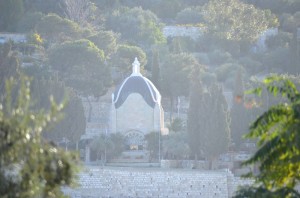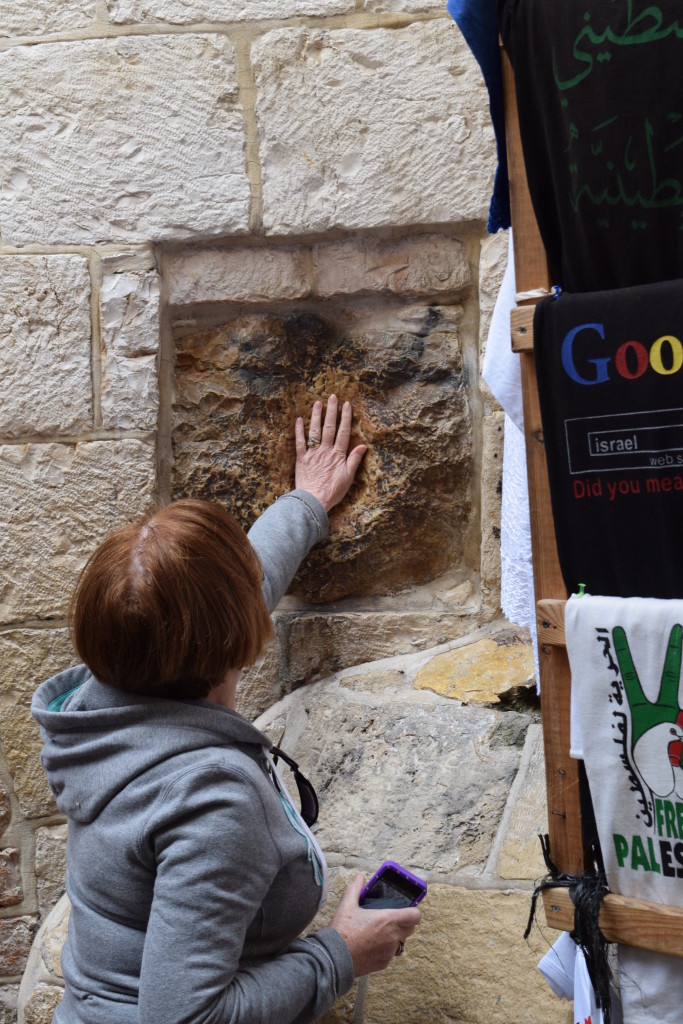Christian Sites
The Garden Tomb
British General Charles “Chinese” Gordon, a religious Christian, stood upon the walls of Jerusalem’s Old City and gazed northward. It was the late 1800’s, and the city was ruled by the Ottoman Turks. Gordon was on a mysterious mission for the British Crown whose true purpose was only to be revealed more than a century later.
Pools of Bethesda & St. Anne’s Church
Now there is in Jerusalem by the Sheep Gate a pool, which is called in Hebrew, Bethesda, having five porches.In these lay a great multitude of sick people, blind, lame, paralyzed, waiting for the moving of the water. For an angel went down at a certain time into the pool and stirred up the water; then whoever stepped in first, after the stirring of the water, was made well of whatever disease he had.Now a certain man was there who had an infirmity thirty-eight years.When Jesus saw him lying there, and knew that he already had been in that condition a long time, He said to him, “Do you want to be made well?”The sick man answered Him, “Sir, I have no man to put me into the pool when the water is stirred up; but while I am coming, another steps down before me.”Jesus said to him, “Rise, take up your bed and walk.” And immediately the man was made well, took up his bed, and walked.
John 5:1-9
There are a couple of special things about the Church of St. Anne. Even in Israel it’s not everyday that you get to walk into a church built in the 12th century (although if you’re walking the Via Dolorosa next, and we bet you are, at the end of your journey you’ll be in the other 12th century church in the Old City). And then there’s the acoustics. We guide Nigerian pilgrims. They really know how to sing and their harmonizing will move the staunchest atheist. The highlight of our 10 day tours occur here where we sit back and marvel at the sounds they produce in this nearly 900 year old building. But it’s not just the Nigerians. Dozens of groups pass through every day with one thought in mind: the glorification of God by making beautiful music composed solely of the human voice.
Acappella group at St. Anne’s Church. Thanks to Joshua Teng
When you leave the church turn right and go down the stairs. You’ll see the Bethesda Pools. In Jerusalem as we dig down into the Earth we go back in time and here we see dramatic evidence of this as the pools lie 20 meters below the modern city.
Mount of Olives

The view from the top of the Mount of Olives, looking across the Kidron Valley at the Old City of Jerusalem, with the New City in the background.
And his feet shall stand in that day upon the mount of Olives, which [is] before Jerusalem on the east, and the mount of Olives shall cleave in the midst thereof toward the east and toward the west, [and there shall be] a very great valley; and half of the mountain shall remove toward the north, and half of it toward the south.
Zechariah 14:4
The view from the Mount of Olives of the Temple Mount and the Old City is unparalleled. Don’t let a tour guide tell you that the alternative view from Mount Scopus suffices. This is the perfect place to sum up 3,800 years of Jerusalem’s history. You should begin your discovery of Jerusalem from here. But one caution: if you come here in the early evening beware. Aggressive salesmen aren’t really interested in sales. They’re looking for your wallet. With this knowledge fear not and go for the sunset. There’s a police station just below the lookout point and rest rooms.
Getsemane/Church of All Nations
Jesus went out as usual to the Mount of Olives, and his disciples followed him.On reaching the place, he said to them, “Pray that you will not fall into temptation.”He withdrew about a stone’s throw beyond them, knelt down and prayed,“Father, if you are willing, take this cup from me; yet not my will, but yours be done.”An angel from heaven appeared to him and strengthened him.And being in anguish, he prayed more earnestly, and his sweat was like drops of blood falling to the ground.When he rose from prayer and went back to the disciples, he found them asleep, exhausted from sorrow.“Why are you sleeping?” he asked them. “Get up and pray so that you will not fall into temptation.”
Luke 22:39-46
Getsemane is a part of a two part complex, the Garden of Getsemane and the adjacent Church of All Nations, now also referred to as the Basilica of the Agony. The word Getsemane itself comes from the Hebrew words Gat Shmanim, which mean Olive Press. This was logical, as farmers would gather their olives from the Mount of Olives, and bring them down into the valley, here, and press them into oil. Here Jesus left several of his disciples, reminding them to remain awake. It was the middle of the night. The disciples had just received an explanation, at the Last Supper, of the meaning of the Bread and the Wine. Jesus removed himself from his disciples and began to pray. Upon his return to the disciples he awakened them and all of them then returned to the other disciples, waiting elsewhere in the valley. Shortly thereafter Roman soldiers and Temple officers, tipped off by Judas, descended upon Jesus and arrested him.
The Church elements, dark purple alabaster windows, stars imbedded on the domed roof, are inspired by the events recorded in Luke. They succeed in conveying to the pilgrim the fear and depression which Jesus felt as he found the rock, located at the front of the church, and began to pray to his father in heaven for intercession. In that brief sentence: “Father, if you are willing, take this cup from me; yet not my will, but yours be done.” Jesus prays for mercy from his fate yet also accepts what must be done to him in the service of mankind.
Dominus Flevit Church
When he came near the place where the road goes down the Mount of Olives, the whole crowd of disciples began joyfully to praise God in loud voices for all the miracles they had seen:“Blessed is the king who comes in the name of the Lord!”“Peace in heaven and glory in the highest!”Some of the Pharisees in the crowd said to Jesus, “Teacher, rebuke your disciples!”“I tell you,” he replied, “if they keep quiet, the stones will cry out.”As he approached Jerusalem and saw the city, he wept over it and said, “If you, even you, had only known on this day what would bring you peace—but now it is hidden from your eyes.
Luke 19-37-42
Dominus Flevit means “The Lord Wept” in Latin. The great Italian architect who designed the church in the shape of a tear drop drew his inspiration from the biblical text, noted above. The church features an unusual feature. The apse in churches is usually located in the East, direction of the rising sun. But here Barluzzi placed it in the direction of the Temple Mount and the effect is powerful.
Via Dolorosa
And when they had mocked him, they took off the purple robe and put his own clothes on him. Then they led him out to crucify him.A certain man from Cyrene, Simon, the father of Alexander and Rufus, was passing by on his way in from the country, and they forced him to carry the cross. They brought Jesus to the place called Golgotha (which means “the place of the skull”). Then they offered him wine mixed with myrrh, but he did not take it. And they crucified him. Dividing up his clothes, they cast lots to see what each would get. It was nine in the morning when they crucified him.The written notice of the charge against him read: the king of the jews.
Mark 15:20-26
1,981 years ago Jesus of Nazareth was forced to walk these streets with a heavy burden. Wearing a crown made of thorns, and bleeding from a beating he had endured from the Roman soldiers, he carried on his shoulders a single plank of wood, destined to function as the horizontal member of the cross on which he was to die. It came from a tree harvested just over two kilometers away in what is today called the Valley of the Cross, in the new city of Jerusalem, under the shadow of the Israeli parliament, the Knesset.
The route leading from sentence to execution is debated by scholars and hinges on the answer to the question: where did Pontius Pilate, the Roman governor, try Jesus. Nevertheless, a case has been made that right here, several meters below these streets Jesus experienced part of his Passion, on his way to Golgotha, where he would be crucified. Today pilgrims trace Christ’s journey daily, along the 14 Stations of the Cross from his condemnation by Pontius Pilate to his burial in the Sepulcher (tomb) near Golgotha (Skull Hill).
Church of the Holy Sepulcher
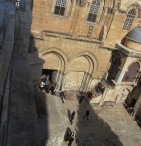
They came to a place called Golgotha (which means “the place of the skull”). There they offered Jesus wine to drink, mixed with gall; but after tasting it, he refused to drink it.When they had crucified him, they divided up his clothes by casting lots. And sitting down, they kept watch over him there. Above his head they placed the written charge against him: this is jesus, the king of the jews.
Matthew: 27:33-37
“Is this really the place?” people often ask. Yes, it is. Here Jesus was crucified, buried and resurrected during the Passover pilgrimage season close to 2,000 years ago. Subsequent actions taken here by the Roman Emperor Hadrian and the Byzantine Empress Helena provide a sense of authenticity to buttress the case for calling this the true place of crucifixion. For a better spiritual experience at this, Christianity’s holiest location, it is best to arrive early in the morning or in the evening before the church closes. At those times it is often empty and pilgrims are left alone with their thoughts and prayers are unhurried.
The Old City of Jerusalem
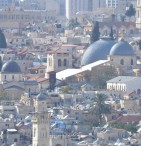
Surrounded by walls built almost 500 years ago by the Ottoman ruler Sultan Suleiman the Magnificent, Jerusalem’s Old City is the critical center to Biblical stories of the Old and New Testament and features in the Islamic Hadith and as such ranks as the most important geographic site in the world for Billions of people.
Caesarea
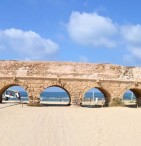
Spend any time in Israel and you’ll come to appreciate Herod the Great. In his time he was feared and hated but to this day he remains unparalleled in the realm of building grandiose projects. And Herod’s projects set the background scene when Jesus of Nazareth began to spread his message of Love. Caesarea ranks among Herod’s greatest achievements. A mere dozen years from conception to completion, Caesarea was the realization of Herod’s dream to provide the Roman provence of Judea with a deep water port that would open the country to international trade. Caesarea became the catalyst to improving the local Judean economy, and it was a city based on the Roman model. As the New Testament narrates the interplay between the Jesus’ disciple Peter and the Roman Centurion Cornelius, the city played a critical role in the developing notion that the teachings of Jesus were not meant for a provincial Jewish audience alone, but instead destined to be shared with all of humanity (Acts 10).
Jerusalem
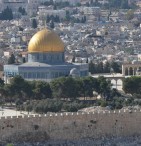
“‘Eternity’ – this refers to Jerusalem”
(Talmud: Berachot 58a)
Jerusalem would not exist but for the human need for connection to the mystery of God.
If you only have one day to spend in Israel, spend it in Jerusalem. Feel the history at every turn. A heavy atmosphere permeates the city, an air of gravity distinctly lacking in coastal Tel Aviv, just an hour away.
Jerusalem sits above the Judean Desert and the views from Jerusalem’s Mt. of Olives toward the desert, the Jordan Valley and the Kingdom of Jordan in the distance are, for the uninitiated, sudden and breathtaking.
Jerusalem remains the key to understanding the three major monotheistic faiths. It has also physically expanded and now is home to over 820,000 people, Israelis and Arabs, Christians, Jews and Moslems.
The mountain air is clear as water
The scent of pines around
Is carried on the breeze of twilight,
And tinkling bells resound.
The trees and stones there softly slumber,
A dream enfolds them all.
So solitary lies the city,
And at its heart — a wall.
Oh, Jerusalem of gold, and of light and of
bronze,
I am the lute for all your songs.
Mt. Hermon: Rugged Vistas and Ancient Holy Sites
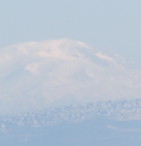
“Come with me from Lebanon, my bride…. Descend from the crest of Amana, from the top of Senir, the summit of Hermon, from the lions’ dens and the mountain haunts of the leopards.” (Song of Songs 4:8.)
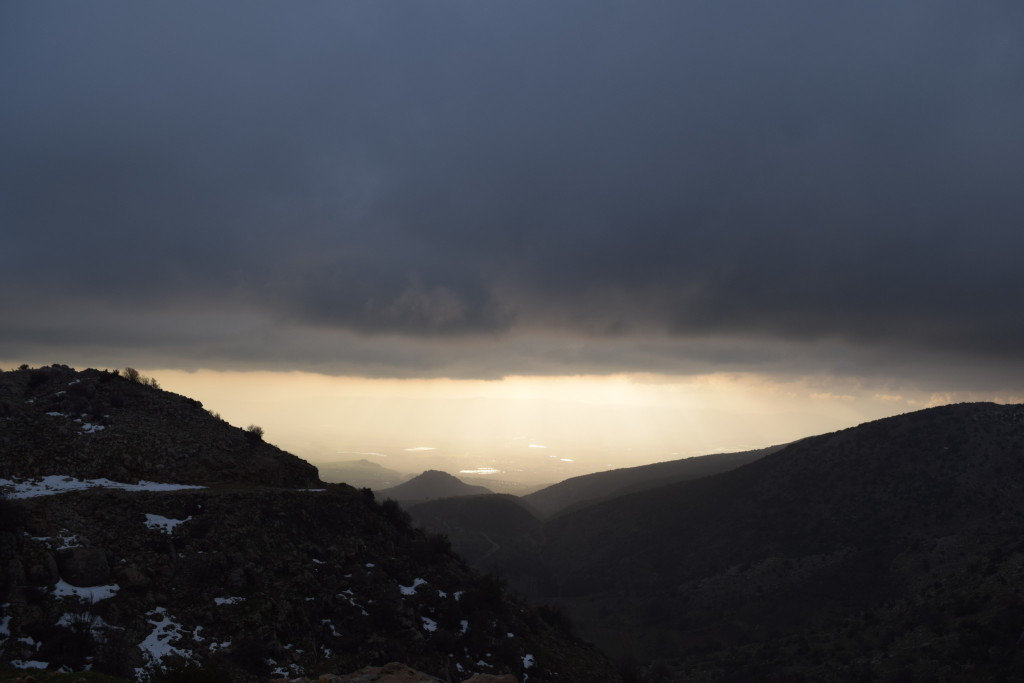
Heavy cloud cover over the lower slopes of Mt. Hermon with the Nimrod fortress, a medieval Islamic structure, seen in the distance.
In ancient times locals ascended the forbidding heights of Mt. Hermon to worship their deities. Explorers have subsequently discovered dozens of temples and holy places in the mountains inaccessible high places. This was the place where God spoke to the Patriarch Abraham at Brit Ben HaBtarim, promising him the Holy Land. Scholars also recognize it as the true site of the Mt. of Transfiguration in the New Testament.
How to put together your Water and Wine tour of Israel
On our Water and Wine Tours website you will not find standard tours.
Don’t worry. We’ll make sure that you experience the must-see sites in the country. But we’ve also included a comprehensive list of sites, by region for people with many different interests, with enough description for you to ascertain whether it’s the sort of place you want to spend your time.
You know your budget and how much time you have to spend here.
So here are our recommendations, based on years of leading all sorts of tours throughout the country.
- Ask yourself if this trip is a vacation. Do you want to see sites but also feel really relaxed at the end of each day? So that you don’t need a few days of sleep upon your return home? If this is the case then try to restrict yourself to three major sites per day. Between the sites, travel and lunch 8-10 hours will pass quickly.
- If you’re more inclined to describe yourself as a pilgrim or someone who wants a survey of sites, then expect to visit up to five sites per day. You’ll be spiritually satisfied but you’ll also need to get a good night’s sleep every night.
“A life changing event”
"Our guide, Zach Levin, made the trip a life changing event for both Linda and me. He was very sensitive to our needs and went out of his way to make sure we got the full Israeli experience. Zach is very knowledgeable and his passion and enthusiasm contributed to our getting the full flavor of the country."
Harvey and Linda W
Your Tour Guide
Water & Wine Tours specializes in individually tailored tours catering to the interests of its clients. Our founder, Zach Levin, is an experienced, licensed tour guide who majored in Middle Eastern Languages and Cultures at Columbia University in the City of New York.
Our tour guides make the history and culture of Israel come alive. They understand that the customer is always right and want you to experience an unforgettable Israel. We’ll take you to places which you’ll love and never forget. When you need to be left alone we’ll sense it. When you need an extra hand we’re there for you.

